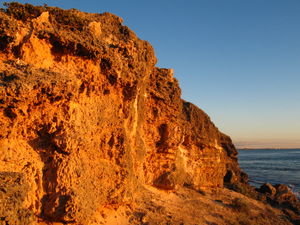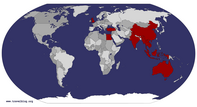Advertisement
Published: September 16th 2007

 Rocks at Cottesloe Beach
Rocks at Cottesloe Beach
The setting sun paints a limestone outcrop with golden light at Cottesloe Beach, WA.
© L. Birch 2007When we awoke to our first morning in Australia, it was to the almost forgotten sounds of indigenous birdsong; wattlebirds, Australian magpies and honeyeaters. Excitedly, I pulled back the blind covering our window and looked outside. It didn't seem to matter that it was a chilly 5 degrees centigrade, nor that it had rained during the night - out there was Australia and we couldn't wait to become re-acquainted with it again.
We had arrived the night before on a flight from Singapore, swapping the heat of tropical Asia for the chill of a southern hemisphere winter. Dropping below the Tropic of Capricorn and alighting in Perth, it was a shock to discover how chilly it was (a balmy 3 degrees centigrade, no less) and that our few 'cool' weather clothes were totally inadequate. Fortunately, Viv's sister Jean - who now lives in one of Perth's southern suburbs - was waiting to greet us with coats and blankets in the arrivals hall.
The Family.... And Other Animals After an emotional reunion; Viv, Jean, nephew Tim and myself, all piled into the family car and made the short journey to their home in Cannington. Despite the hour, we had

 Seasonal Waterfall @ JFNP
Seasonal Waterfall @ JFNP
A seasonal waterfall in full spate at John Forrest National Park outside Perth.
© L. Birch 2007sat talking 'til after midnight. Jean had laid on a welcome supper - food long denied us on our trip through Asia - and we tucked in with gusto, enjoying the first glass of white wine we had tasted in more than 10 months of travel. There were other forgotten delights too including cheese, Branston pickle, Pâté and sliced ham: we thought we had died and gone to heaven!
We were up and dressed surprisingly early considering how exhausted we had felt the night before, but a new day and 'new' country was waiting and we didn't want to waste a minute of our time. It may have been cold but the sun was shining and that most Australian of bands, "Midnight Oil" were playing on the radio as I stood preparing breakfast dressed in a beanie hat and borrowed fleece. Our first port of call were the Op Shops - the Australian equivalent of our charity shops back home - where we stocked up on some warmer second-hand clothes. With the sun out, it was warmer during the day but after average temps of 33 degrees C in Asia, 17 degrees felt decidedly cold.
Over the next

 Parrots Galore!
Parrots Galore!
Parrots - like these colourful rainbow lorikeets - were a common sight throughout the Perth area.
© Ian Johnson 2007few days, we embarked upon a whirlwind tour of the Perth area, catching up with family and friends. There were brief stays with 75 year old Aunt Bette in Woodbridge, whose youthful energy put us to shame, and visits to see cousins and old friends scattered around the city. My cousin Hazel, who everyone thought was going to be living the life of a 'twenty-something' forever, was not only married now but also had a two-year old daughter that she and husband Ian doted over. Getting to know the latest member of the family was... interesting. Little Helena definitely had her own ideas about what was acceptable and at first, our presence obviously didn't fit into that category. Who were these strange people coming into her home, she must have wondered and dealt with the situation by bursting loudly into tears and throwing herself onto the floor. Were we really so terrible? Hazel took it all in her stride and during one such episode - when even Helena's favourite TV programme, "Peppa Pig", failed to quell the tears - we asked Hazel if she would like a glass of wine in compensation for our disruptive presence in their lives. "Ah,

 Ring-Necked Parrot
Ring-Necked Parrot
One of the commonest parrots to be found around Perth is often simply referred to as a "28" - due to its call, which sounds like, er... 28!
© V. Birch 2007yes please", she said in her delightful Aussie accent. "I find a glass of wine takes the edge off parenting," she explained. We could drink to that, and we did... several times!
We also caught up with cousins Kate and Michael (who told appallingly awful jokes: "I went to the doctor the other day complaining that I felt like a pair of curtains... he told me to pull myself together.") and in between visits with the family, we squeezed in side trips to Perth and the Darling Ranges to the east of the city. On one such occasion, we took a bus from Midland - at the end of the metropolitan train line - up into the low hills of the Darling Ranges. Our destination was the John Forrest National Park, a reserve encompassing 2700 hectares (6671 acres) of natural bushland. Australia lacked any of the dazzling cultural highlights of Asia. Its oldest buildings were little more than 150 years old and there were no ‘lost cities’ or sumptuous temples. It was true that human settlement dated back 60,000 years but aboriginal influence was marked by its low impact upon the land and its environments. What was really fascinating

 Dryandra Flower
Dryandra Flower
Spring is the time to see protea-like Dryandras in bloom in the southern forests of WA.
© L. Birch 2007about Australia however, was its natural history, the beauty of its landscapes and its unique wildlife. Where else in the world could you find such strangely named creatures as; quokkas, pobblebonks, bandicoots and numbats? The answer was, no-where else and the reason was due to Australia’s isolation, far from the evolutionary events that - elsewhere in the world - had ‘de-selected’ marsupials and egg-laying mammals (the monotremes, of which 3 survive in Australia) from the tree of history.
Australia’s alternative history began around 70 million years ago when, having finally broken free of the Gondwana landmass, it drifted northwards to collide with Asia. Like the Ark of biblical fame, it carried with it a cargo of plants and animals that died out elsewhere but flourished and proliferated in an environment free of other influences and competition. Quite possibly, the first that any European knew about this strange land was when it was surveyed by Capt. Cook and Sir Joseph Banks. Banks was particularly interested in the region’s natural history and gave the ‘modern world’ its first description of a peculiar animal that looked like a cross between a giant rabbit and a donkey, stood on its hind legs and

 Perth City Skyline
Perth City Skyline
The tower blocks of Perth - as seen from Kings Park - rise up from the flat, coastal plains bordering the Indian Ocean.
© L. Birch 2007hopped instead of ran!
‘Hopping’ off the bus and diving into the bush, we hoped that we might see a kangaroo ourselves but regardless, it was just good to be out in the countryside among gum trees and the first wild flowers of spring. There were seasonal rivers and waterfalls in full spate but it would only be a matter of weeks before these were bone dry and water just a memory. Evidence of just how dry it would soon become lay all around us; lumps of charred wood and the blackened trunks of gum trees - all bore witness to the wrath of previous summer bushfires. But at that time, it was hard to believe that anything could disturb the green tranquility of the escarpment. We didn’t see any kangaroos on this occasion but there were many plants in flower including; Australian wattles, native irises and the strange other-worldly flowers of kangaroo paw (
Anigozanthus spp). There were also parrots - lots of them. More parrots in fact, than we had seen anywhere else on our trip. Even in the heart of Perth, you could not fail to see galahs and exuberantly coloured rainbow lorikeets. Just a short walk

 Kangaroo Paw
Kangaroo Paw
The floral state emblem is a beautiful but bizarre looking flower belonging to a genus of plants found only in Western Australia.
© L. Birch 2007into the suburbs - or beyond - and you could expect to see many more, from ring-necked parrots to big black cockatoos that screeched loudly from the tops of their favourite gum-nut trees. After a walk out to the Park Falls, we stopped to eat a small packed lunch and were soon besieged by hopeful scavengers. First to arrive were the magpies with their strangely musical calls - so evocative of Australia. Next on the scene were the ring-necked parrots and finally a pair of kookaburras that laughed and chided from a tree above our heads.
From up on the escarpment, we could see the tower blocks of central Perth glittering far below on the flat coastal plains bordering the Indian Ocean. Perth offered experiences of a different kind. Despite being the largest city in Western Australia (and often described as the most isolated city in the world), Perth feels more like a big town than a capital city. Locals sometimes feel defensive about its perceived shortcomings but they shouldn’t. It is a clean and spacious garden city that merges pleasantly with the coastal bushland that surrounds it. Northbridge is the place to head for bars, restaurants and nightlife

 Everlasting Flowers
Everlasting Flowers
Papery everlasting flowers, like these in Kings Park, often carpet the ground in the arid regions during spring.
© L. Birch 2007while the city centre has an extensive range of shops, an excellent museum and an art gallery - all of it accessible on a free bus service. Perth’s greatest asset however, is its noble botanic garden - Kings Park - which celebrates the diversity and abundance of WA’s wildflower heritage and incidentally, provides stunning views of Perth and the Darling Ranges beyond.
WA’s Wildflower Magic Each year, WA plays host to one of the world’s most incredible natural phenomena, when huge numbers of wildflowers burst into dazzling bloom. Some 12,000 different species have been discovered in WA, many of which are endemics - a record matched only by a handful of other places around the globe. On a previous visit, we had been fortunate enough to see an area of - usually - arid bushland transformed into a sea of pink, yellow and white everlasting flowers that stretched as far as the eye could see. However, if time was short and you were unable to catch the spectacle in the wild then the Kings Park Wildflower Festival - staged between September and October - offered the next best alternative. But flowers, what’s all the fuss about, you could see them anywhere surely? Not these flowers you couldn’t. In just the same way as Australia’s wildlife had evolved into strange and quirky forms, so too had its plants. Australia boasted many beautiful and unusual plants from
Banksia’s and bottle brush trees to spider orchids and kangaroo paws - many of which were just coming into flower when we visited Kings Park.
It certainly provided a colourful and fitting climax to the first half of our mini Australian adventure. But a few days of sunshine and wildflowers had lulled us into the false belief that spring had arrived. It was still cold, and it would probably have made more sense to head north for the second half of our trip, but we had other plans. Friends we had not seen in years and a new part of the country that we had yet to explore - were waiting in the south.
Advertisement
Tot: 0.293s; Tpl: 0.012s; cc: 29; qc: 131; dbt: 0.149s; 1; m:domysql w:travelblog (10.17.0.13); sld: 1;
; mem: 1.5mb











